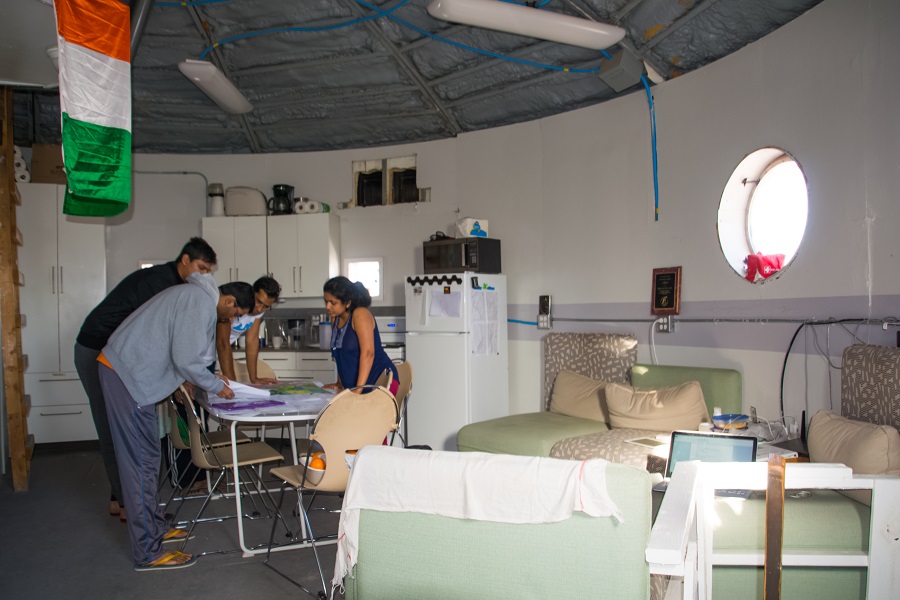
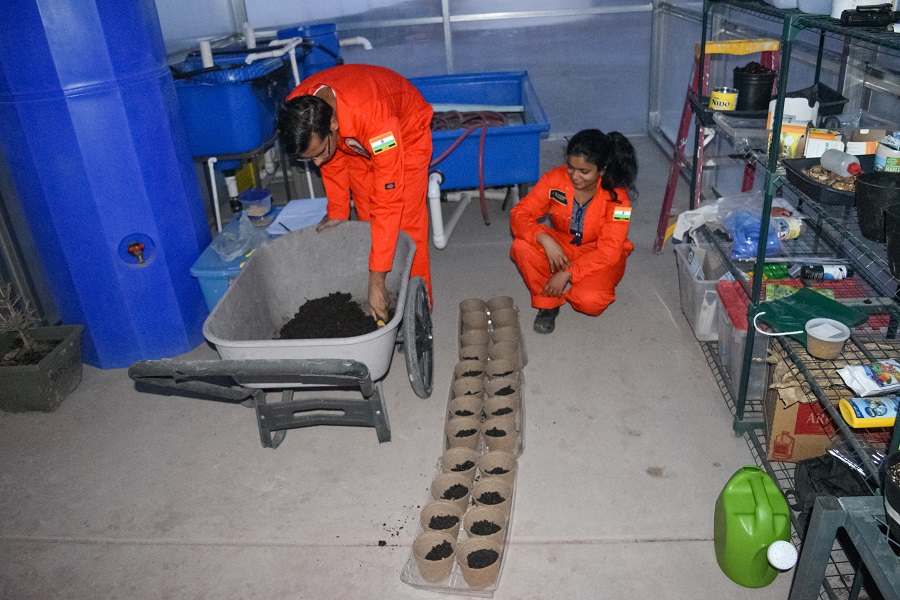


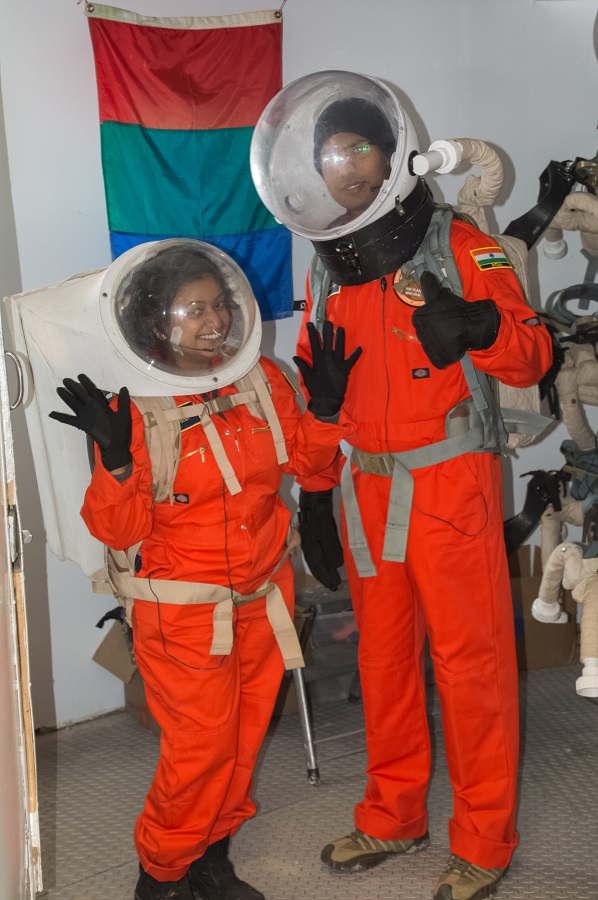







Green Hab Report
Report written by: Sneha Velayudhan (Crew Biologist)
Date : 01/31/2017
Functionality: The heaters in the green hab is in perfect working condition. The temperatures are monitored twice a day. Today it was noted that the temperature in the green hab was around 48 degree centigrade while the temperature outside was 10 degree centigrade around 11:30 AM. As the temperature was too high the cooler was switched on and the green hab temperature was brought down to around 33 degree centigrade. The seedlings were watered twice today. The temperatures were monitored in the evening, it was noted to be 23 degree centigrade inside while the outside temperature was around 8 degree centigrade.
Status: The fenugreek and the Chick pea seeds have germinated well and are ready for potting. The pots are prepared with earth soil for the experiment to monitor the effect of Vitamin D on the growth of plants. An EVA was done to collect different types of soil from different locations on Mars. There were 5 different types of soil collected. The soil collected are different in color and texture. Seeds will be planted in each of the soil type and the seedling growth will be observed. The existing seedlings were monitored for growth. The height of the corn plants were measured.
Planned activity: The germinated seeds will be planted into the earth and martian soil. There will be 2 sets each of 10 pots marked in increments of 0 – 0.9 g of Vitamin D. One of this set will be placed in the Green Hab and the other under the misian Mars light and growth will be monitored.
EVA Report:
SOL: 02
Earth Date: 01/31/2017
Person filling out the report: Saroj Kumar
Crew members involved in the EVA: Saroj Kumar, Sneha Velayudhan
EVA leader: Sneha Velayudhan
Begin: 11.42 am
End: 02.00 pm
Type of EVA: Walking + Driving (Phobos)
Purpose: Mars soil sample collection for GreenHab experiments
UTM Coordinates: 1. Northing : 4251500 Easting : 519050
Mars Desert Research Station End of Mission Summary
Crew 173 – Team PRIMA
Team PRIMA:
Commander/Astrobiologist: Michaela Musilova (Slovakia)
Executive Officer: Arnau Pons Lorente (Spain)
Engineer/ Astronomer: Idriss Sisaid (France/Morocco)
GreenHab Officer/Astrobiologist: Richard Blake (Australia)
Crew Artist/Journalist: Niamh Shaw (Ireland)
Crew Health & Safety Officer/Geologist: Roy Naor (Israel)
Team PRIMA is made up of highly qualified scientists, engineers, artists and leadership experts from all over the world. We all first met during the International Space University (ISU)’s Space Studies Program. The crew was successful in undertaking a wide range of research projects and outreach activities at the Mars Desert Research Station (MDRS) during their mission there, detailed below. One of the keys to the smooth running of the mission and projects were great group dynamics, and the multicultural atmosphere the crew nurtured. Amongst other things, we regularly organized “culture nights”, in ISU’s spirit, during which the different international traditions and cuisines of the crew members were presented. Another thing, which bonded the whole crew, was our passion for reaching out to the public and inspiring others to pursue their dreams, just like the crew is doing. They believe this mission alone helped raise the awareness about the importance of the space sector in all of the crew members’ countries.
Research conducted at MDRS:
The aim of this project was to develop and test 3d printed blocks, which can be used to build multifunctional buildings on Mars. The shape of the blocks was optimized to withstand different types of heavy loads, contain water (for daily use by astronauts) and to provide extra-radiation shielding for the astronauts. Furthermore, the idea was to use in situ resources to make the blocks, therefore minimizing the amount of material that would need to be transported to Mars.
The first week at MDRS, we encountered several issues with the 3D printer present here (including the cold temperatures at night for example), which didn’t allow us to print bricks but we managed to print 5 bricks over the last few days (Figure 1). Every brick took 17h on average to print. The outer shell of the brick was printed using PLA filament (plastic). For future studies, we suggest laser sintering technology to simulate 3D printing using Martian soil. The printed blocks are, however, a great success as the interlocking system was fully functional. With the crew geologist Roy Naor we evaluated the different types of soil that can be used within the brick to strengthen it. Filling the blocks with appropriate soil was also successful and the process was fairly easy (less than 1min per block). We then built a small structure at MDRS during an EVA, in order to prepare for the next iteration of the proof of concept.
Figure 1: the first 3D printed brick on “Mars”
The work in the GreenHab during this has mission comprised of three main experiments:
The temperature fluctuation was measured across the day, from a range of locations: inside the GreenHab, inside on the ground floor of the main Hab, outside, and, inside the grow tent (which was initially located within the GreenHab). The results are presented in Figure 2.
Due to the extremely high temperatures in the growth tent (50◦C ~120◦F), the grow tent was moved to the lower level of the main Hab. With the grow tent inside the main Hab, its temperature hardly fluctuated at all (Figure 3). With ~65% humidity, it now represents an ideal seed germination area. The GreenHab still gets quite hot during the day, getting to ~40◦C (~105◦F), but with no wind and regular watering, the plants thrive. Similarly, with a working heater, the night- time temperatures now only get as low as ~17◦C (~63◦F), which is a perfectly adequate temperature to keep edible plants happy.
Figure 2: Sol 1 temperatures
Figure 3: Sol 7 temperatures
This involved two similar experiments designed by universities in the Czech Republic, and brought by the crew commander, Michaela Musilova. The first was a corn experiment, designed by researchers at the Masaryk University, to be used as a base line for a future experiment testing the effects of heavy metals on the growth of corn (Figure 4). The experiment at the MDRS involved measuring the height of corn seedlings each day as well as recording the number of leaves each plant had. Figure 4 shows the growth of the corn seedlings after only a few days of being in the grow tent.
The second experiment saw six different crops sown in pots with seed densities ranging from 1 to 12 seeds per 4 cm2. Some seedlings have already sprouted but it is still too early to gather meaningful results. This experiment is to be followed up by researchers at Mendel University.
Both projects are to be continued by future crews at MDRS – we will leave them appropriate instructions for this. Hopefully, in this way, we will be able to engage multiple crews in this international project.
Figure 4: Corn growing experiments
This experiment was borne of the need for more soil to grow plants in. Samples of soil were collected from geological locations in the surroundings of MDRS. These samples were tested for their pH, as well as salinity. With kitchen and garden scraps forming compost, this could improve the regolith to the point it could be used to grow more crops in the future. Hopefully, this could reduce dependence on outside sources to bring in more potting mix, and more fully recreate a Martian simulation. Unfortunately, the instruments to measure pH and salinity at the MDRS were insufficient for this, and thus this experiment warrants further investigation.
The potential of extraterrestrial life on Mars is well connected to the history, and distribution of water and carbon on the planet. Carbonate minerals are seen as powerful tools with which to explore these fundamental relationships, as they are intimately tied to both the water and the inorganic carbon cycle. The carbonate analysis work at MDRS concentrated on locating and sampling carbonate minerals in the topsoil and exhumed formations in the Martian-like environment. After an initial study of the geology of the area, carbonates were sampled and tested on site, using HCl 5% to test for a reaction of the rocks with the acid. The verified assemblages were then brought back to MDRS for further testing. The sampling was performed in a very rigorous way, documented meticulously, while keeping the work analogous to what extraterrestrial field work would be like one day.
The samples will be sent for analysis of the carbonates’ chemical and isotopic fingerprint at the Weizmann Institute of Science (Israel) (including crystal separation, mineral/chemical identification (XRD, EDS, CL), textural analysis (SEM, micro-CT), isotopic analysis (SIMS)). The results will be added to their datasets with the intention of publishing them in academic journals.
The aim of this project was to capture the public’s interest in Mars, MDRS and Space:
We believe that we accomplished these aims: together we documented our entire experience here at MDRS using audio, video, timelapse, 360 cameras and photography. We began by making videos pre-mission to reflect the time and effort in preparation for our mission. During mission, we captured every EVA in photography and video and conducted time lapse videos of our experiments, and daily life during our mission. We will continue to record our experience post-mission to capture further reflections about our experience at MDRS. During our mission, we shared a summary of our daily activities on social media and on blogposts in our native countries using this content. We also created short 90 second tutorial videos for school children to inspire them to consider careers in STEM, especially in the space industry, to be posted to our YouTube channel post-mission. We also worked with a number of companies, research institutions and journalists/media organizations around the world. Awareness of Mars and MDRS has most definitely been achieved, and we all return home to requests for further interviews and requests from schools to speak about our experience here.
One of our outreach projects involved a challenge for high school students in Israel to design a set of small experiments for the team to conduct under simulation. They were: 1) Detecting variances in rock type near MDRS (involving sampling and examining the geological characteristics of each of the formations present here); 2) Testing the strength of the 3D printed bricks as a function of the different rock material they will be filled with (thus testing the variance in their strength properties ); and testing the effect of repetitive EVAs on the time it takes the crew to prepare for it (timing and documenting the process of putting EVA equipment on). All crew members took part in this research lead by Roy Naor. The projects yielded interesting results. For instance, there was a great improvement in the EVA preparation time (decreasing from 30 minutes to 15 minutes throughout the mission). This projects already got a lot of media coverage and the results be published in the Israeli media after the mission.
Michaela Musilova organized a competition for high school and university students in Slovakia called Mission to Mars (Misia Mars), together with Slovenske Elektrarne. The aim of the competition was to motivate young people to design an experiment worthy of being taken and performed on Mars, whether real or simulated at MDRS. Students from all over Slovakia participated in the competition in 2016. The winning experiment has been brought to MDRS with Crew 173 (Figure 5). It is focused on enhancing the speed and yield of spinach growth under simulated Martian conditions. Michaela communicated regularly with her students in Slovakia, who remotely advised her on how to perform it. The experiment was very successful, as the spinach grew much faster than the spinach grown in the GreenHab. It also yielded enough leaves to treat the crew to a mini spinach salad on their last evening at MDRS. All the follow-up analyses will be performed in the students’ school in Detva, Slovakia. As per the other outreach activities, this project attracted a lot of attention from the media and was followed by many schools throughout Slovakia.
Figure 5: Mission to Mars experiment at MDRS
A practical way of eating is the key to long-term expeditions in extreme conditions on Earth and in future long-duration missions in space. Food will have to be compact (for easy transportation), full of the most important nutrients (for maintaining good crew health and performance), but also diverse for all the different human senses. Hence, a project focusing on food for extreme conditions (nicknamed “space food”) has been prepared by the Slovak Organization for Space Activities (SOSA) and several Slovak research institutes and companies. The aim of the work at MDRS was to monitor the changes in the quality of the space food products and their nutritional content, rather than to test the products on the crew. In particular, the effects of the different extreme conditions (e.g. varying temperatures) on the food were studied for health and safety reasons. The project went very well and most of the products managed to survive the simulated Martian conditions. Further analyses will be performed at the Slovak institutes upon the return of the products to Slovakia, with the aim of publishing the data in academic publications. Future plans include using the data in the food industry, and preparing products for athletes and even the military, even one day for the space sector.
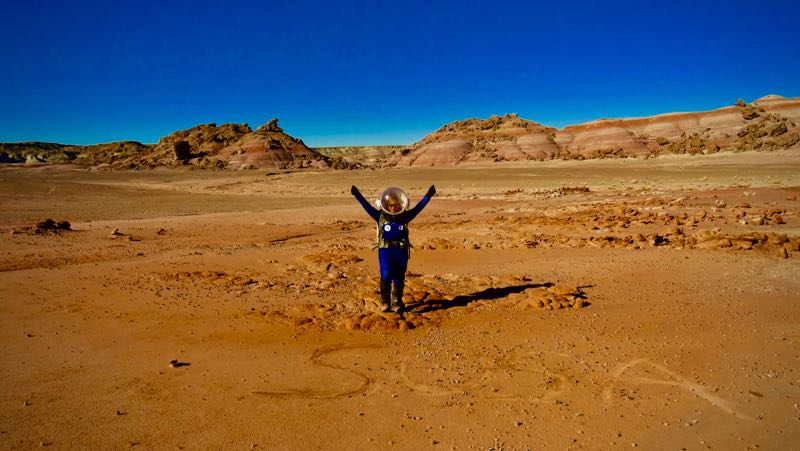


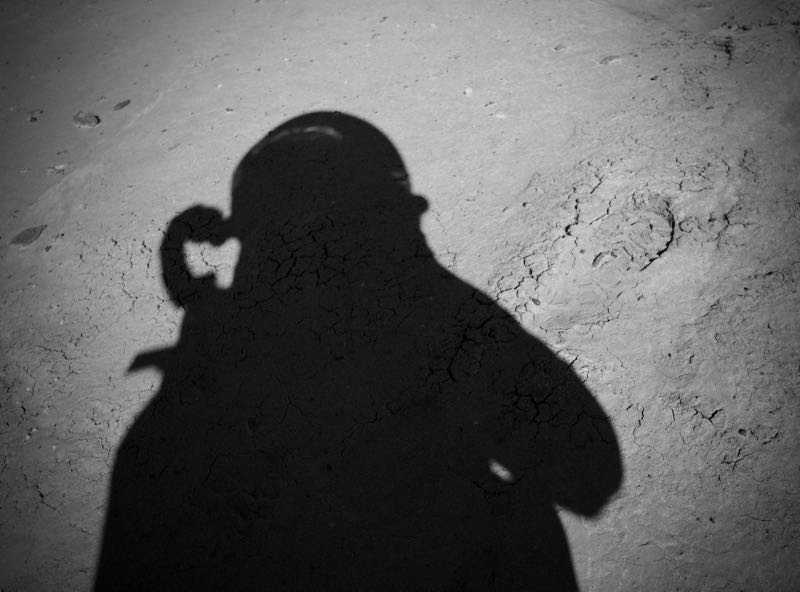
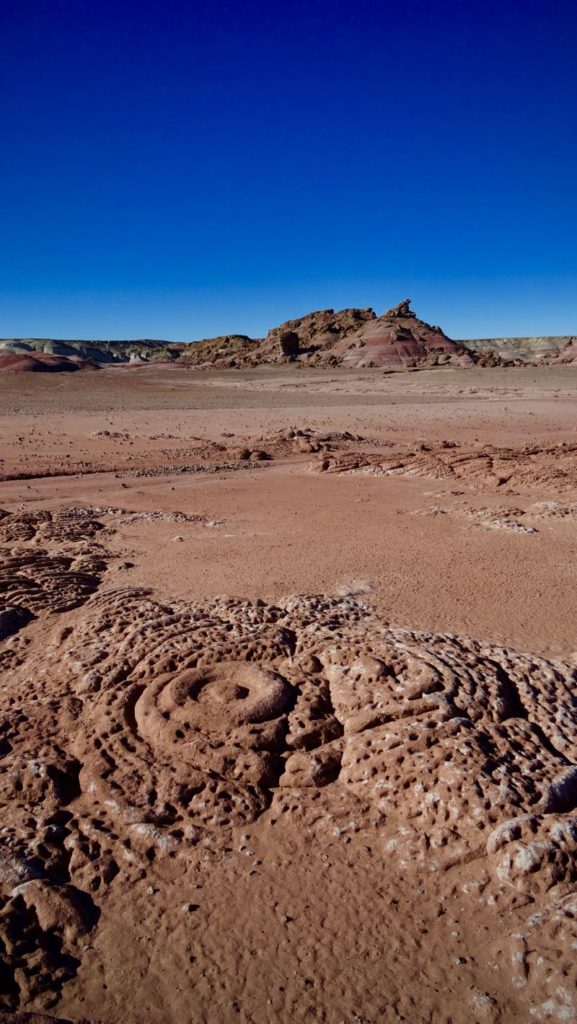
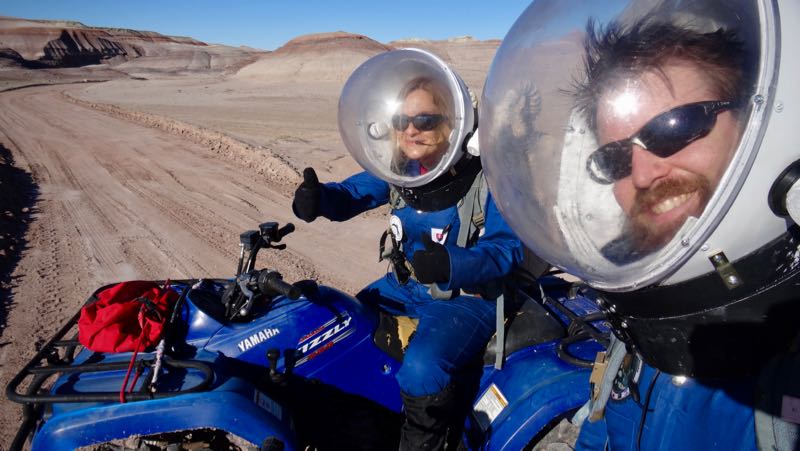
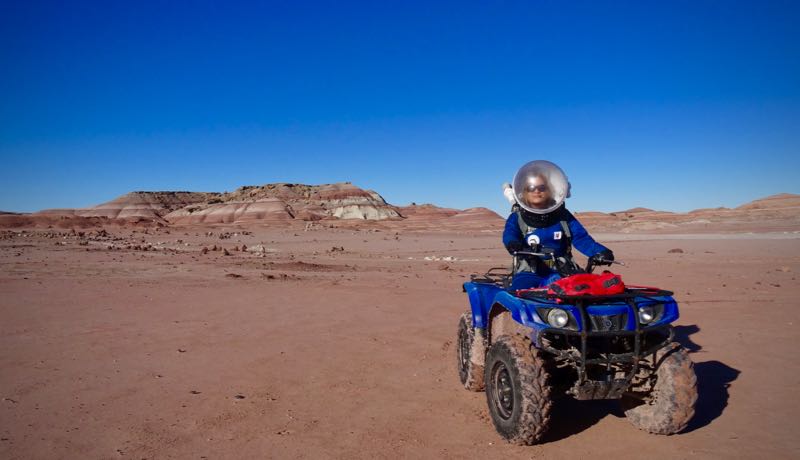

EVA report:
SOL: 12
Earth date: 27/01/2017
Person filling out the report: Michaela Musilova
Crew members involved in the EVA: Niahm Shaw, Idriss Sisaid and Michaela Musilova
EVA leader: Michaela Musilova
Begin: 09:30 am
End: 1:00 pm
Type of EVA: Walking+ 2 ATVs
Purpose: Outreach activities around the Hab and last sampling of hypoliths.
UTM Coordinates: Northing : 4249100 Easting : 518000 Zone : 12 S
Summary: Outreach activities (with photos and videos) around MDRS and further hypolith sampling by the Kissing Camels ridge.
MDRS Sol Summary Report for Sol 12
Crew Journalist & Artist Niamh Shaw
Summary Title
The curse of the Gigabyte Hobgoblin
Mission Status:
We are all doing well, our experiments are now complete and we are
finishing off our remaining out-reach activities as part of our mission.
Sol Activity Summary:
Action! So many movies were made today it was hard to keep up with all the
activity. And the weather couldn’t have been better for shooting. But first
we took a call from The Sunday Times newspaper for an interview. We thought
it was going to be a brief 20 minutes group call and ended up being over 90
minutes in duration. What can I say? We wowed him with stories of our
mission. Here’s a brief sum-mary of the outreach and art activities
happening around here today: Niamh was shooting her art pro-ject in the
communal areas, Roy was filming his outreach movies in the Science Dome,
Idriss was using the EVA to make an outreach movie and Rick pulled himself
in many directions to assist every-one in their needs. Roy then made a
‘walk and talk’ outreach movie about MDRS and our life here. Michaela and
Rick went out on a second EVA of the day to collect one last set of
hypolith samples. Michaela then spent some time in the Science Dome
analyzing her samples and working on her scien-fitic projects. Lastly Roy
and Idriss finally built their wall with 3d printed bricks, and filmed
their suc-cessful proof of concept. We took over 600 photographs today and
made approx 10 movies. All content for us to bring back to our home
countries and share our adventure with everyone. On the home stretch now….
Look Ahead Plan:
We have to finish some minor outreach stuff in the morning, give the Hab a
good clean for Crew 174 and head out on one last EVA as a crew together.
Then its one last group picture and then we look forward to welcoming the
new crew to MDRS.
Anomalies in work:
The gigabyte goblin continues to strike, we will never know who or what was
eating all that data.
Weather:
A perfectly wonderful day on Mars today. Warm, the sun shone and dry all
day.
Crew Physical Status:
All crew are alll doing well. Still laughing.
EVA:
A short EVA in the morning for Niamh and Idriss for outreach activities and
then in the afternoon Michaela and Rick went on EVA to collect hypolith
samples.
Reports to be filed:
sol 12 summary
Eva report
Eva request
commander’s report
Operations report
Commander’s report Sol 12
Vangelis. The 1492: Conquest of Paradise theme. That is what is going through my head now and has been all day. All week. All mission actually. It all started with Idriss, our crew engineer, playing the song at the start of our mission many sols ago. Then one by one each crew member has been humming the song while working, cooking, in the shower, in the toilet… Basically all the time. Today Roy, our crew geologist, hummed it a number of time into our walkie talkies during his EVA and now my crew are all listening to it while preparing for dinner. This fairly powerful and inspirational music gets to us not just because it’s catchy, but because it resonates within us. It awakens the explorers, the adventurers, the scientists and visionaries in our souls. It symbolises what has united us all in going to Mars in the first place. The music’s power fuels our desires and makes us feel invincible in reaching our dreams.
While I hear my crew singing the song together by the dinner table, it also fills me sorrow and nostalgia. How many more times will be sing the song together? How many more times will we share the “cancer” juice over dinner? How many more times will we start all of our walkie talkie calls with “Bla bla bla, this is Roy” and end them with “over”? I cannot even imagine now not hearing the loud pump go off while I pour water into the kettle to make tea. I will probably spend the next few weeks being paranoid about using the wifi and will turn all my devices on airplane more when it is not time to communicate with Mission Support.
I will definitely not miss praying to the “toilet god”, as we call it, each time we want to flush the toilet, just so that we do not have another toilet-clogging problem. It will be very refreshing to take a shower more than once a week and I cannot wait to bite into a juicy apple. I will also enjoy not checking on the crew all the time and trying to solve the mystery of the Gigabyte Hobgoblin, who has been eating Gigabytes and Gigabytes of our data. My body has been craving a good run and exercise out in the nature. Not to mention my family, friends and colleagues, who have been writing to me almost desperately, barely getting a message from me all the way from Mars.
Nevertheless, none of these things would make me want to leave Mars any sooner or at all to be honest. I have become a Martian and so has my whole crew. We have adapted to our life here and it will be painful for all of us to prepare for the journey back to Earth. We will miss working together, sharing stories, cultural nights, music to hum together and silly walkie talkie conversations. We have all caught some sort of Martian sickness: from regularly making strange animal noises, obsessive-compulsive cooking or cleaning, and simply laughing our heads off all the time. I have not cried from laughter so often, perhaps ever in my life. Our strange way of life may seem crazy to the aliens observing us here or our fellow Earthlings back home. However, for us our laughter has been our source of energy, our medicine and the key to our successful mission here on Mars.
We will be Martians forever in our hearts and the bonds we have created here will remain with us for the rest of our lives. Our experience here will be the fuel for our passions, just like the Vangelis song. We have made the conquest of Mars. Now it is time to achieve the rest of our dreams.
Ad Astra!
Michaela Musilova
Mars Crew 173 Commander